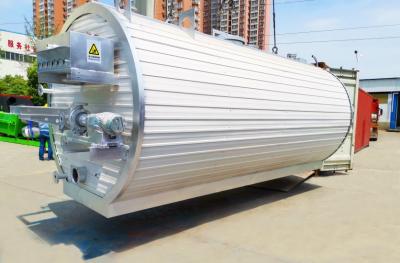Concrete mixing plant technology
Concrete mixing plant technology status and its development trend, do you know?
Concrete mixing plant is a kind of electromechanical equipment that measures cement, water, aggregate, admixture, admixture and other materials according to the concrete proportioning requirements, and then mixes them into qualified concrete. Concrete mixing plant includes material conveying, measuring, storing, mixing, auxiliary and control system and other parts. Concrete mixing plant is mainly used for railroad, kilometer, bridge, airport, tunnel, hydropower and water conservancy project, soil industry, mining and civil construction, as well as commercial concrete and concrete products production. Concrete mixing plants are arranged in many forms with different specifications. For example, it can be divided into hydraulic station, nuclear power station, high speed railway station, pipe and pile station, engineering station and commercial mixing station according to different purposes; mobile station and fixed station according to the convenience of relocation; double machine station and single machine station according to the number of host configuration.
Development history of mixing plant
1、History of foreign development
After the invention of "Portland cement" by British Aspectin and "Roman cement" by British J.parker in 1796, concrete mixing plant was born. In the early days, the concrete mixing plant mixing form using a single machine mixing, commercial concrete was used before it really entered the centralized mixing mode. Germany Zui early use of commercial concrete ten, its shou commercial concrete mixing plant in 1903 in Stahlberg established. In the early days of the plant, it used dump trucks or motorized dump trucks to deliver concrete, which made it difficult for the quality of concrete to be... From the 1960s to the 1970s, the economic development of various countries was rapid, and commercial concrete was also developed rapidly. By 1973, Japan's commercial concrete mixing plant reached 3,533, the United States of America's concrete mixing plant reached 10,000. 1980s to 1990s, Japan's commercial concrete than in 1973 fell by 0.21, tending to saturation. To... The number of this mixing plant remains at about 5,000.
2、Domestic development history
Concrete mixing plant in China started late, to the mid-1960s before the production of vertical shaft vortex type mixer, the early 1980s began to produce horizontal shaft mixer, the mid-1990s began to produce planetary vertical shaft mixer, only to the 1980s to the 1990s really de to achieve rapid development. 1980s, with the rapid development of the national economy, concrete mixing plant has been rapid development. At this time, the main mixing machine of the mixing plant was mainly single and double horizontal shaft, the weighing was mainly electronic scale and mechanical electronic scale, the feeding method was tape machine feeding, cantilever pulling shovel, lifting bucket feeding, etc., and the control system was in the form of industrial control machine and single-chip computer, etc.
Concrete mixing plant finished product classification
Concrete mixing plant products are installed in various forms. Generally, according to the fixed form, they can be divided into mobile mixing plant, fixed mixing plant, ship-mounted mixing plant and foundation-free mixing plant. Mobile mixing plant is mobile and can be moved at any time. It is suitable for various sites with small concrete consumption and short construction period, so it usually needs to be equipped with walking device. Fixed mixing plants are fixed on the foundation by bolting or welding, and are mainly used in large precast plants, commercial concrete plants and water conservancy construction sites, where the production capacity is generally large. Ship-mounted mixing plants are generally used in the construction of cross-river bridges and large span cross-sea projects. This type of mixing plant is suitable for concrete construction in wide waters away from land, and can be moved with barges in the construction waters, and all types of concrete can be mixed. The base frame of the foundation-free mixing plant is not connected to the foundation of the site where it is located, so the equipment can be dismantled and installed quickly, and the foundation construction is small, and it is usually fixed on the installation base frame.
Classification according to the characteristics of concrete produced
According to the characteristics of the concrete produced, it can be classified into hydraulic station, nuclear power station, commercial concrete station, high speed railway station, etc. The hydraulic station is a mixing plant mainly used for mixing concrete production of dams. Concrete for culverts, slopes, roads and other power station auxiliary facilities do not differ much from general engineering concrete. In contrast, the concrete aggregates for building hydropower dams are larger in size and require more aggregate gradation. In order to enable the mixing mainframe of such mixing plants to withstand the impact of large blocks of material, the number and angle of its mixing arms are arranged in some special ways.
The concrete required for the construction of nuclear power plants is usually divided into 2 categories: conventional island and nuclear island. The concrete required for the nuclear island is of high performance and the concrete to be poured is thick and large, so it needs to be equipped with an ice making system and has special requirements on the temperature and mixing process.
The commercial concrete station is used to produce ordinary commercial concrete, it belongs to the common concrete mixing equipment, and the scope of application is geng wide. High performance concrete is produced in high speed railroad stations mainly for high speed railroad construction. High-speed railway mixing plants are individually metered to meet the high requirements for measurement accuracy of various materials. The production process of concrete for high-speed railway construction is complex and the mixing cycle is relatively long, generally 2-3 times that of ordinary commercial mixing plants. In general, the mixing efficiency is lower than that of ordinary commercial concrete plants, only 1/3 to 1/2 of that of ordinary commercial concrete plants.




